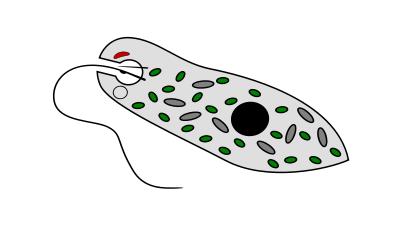BY LETTER
Protist
A blanket term for the very large number of Old Earth eukaryotic phyla that are neither animals, nor green plants, nor fungi. It is no longer used in taxonomy; to say protist is rather like saying worm or fish, both terms which are too broad in their definition to have real taxonomic significance.
The various kinds of organism known as protists are otherwise not particularly strongly related to one another, other than in their common heritage as eukaryotes; they represent not a clade but a rather loosely defined grade of organization. Most protists are single-celled, or if they are multicellular organisms they have a simpler structure and less cell differentiation than typical animals, plants, or fungi. Exceptions to this general rule are the phaeophytes, or brown algae, and the rhodophytes, or red algae. Examples of organisms that are called protists include dinoflagellates, red algae, brown algae, green algae, diatoms, forams, ciliates, amoebas, and slime molds.
Though many protists have been gengineered for a variety of purposes, from use in industrial vat-tech to agriculture to components of artificial ecosystems, relatively few have been provolved. Brain kelp, derived brown algae, are a well known exception. Some hobbyists have created alternative species, or even entire alternative ecologies, of land plants using diatoms, red algae, brown algae, or other photosynthetic phyla as a starting point rather than the green algae that gave rise to the plant kingdom on Old Earth.
Xenobiont protist analogues exist on gardenworlds wherever eukaryotic-grade morphotypes have arisen, and in fact worlds that contain nothing more complex than protists are much more common than those with the full range of animal, plant, or fungal kingdoms.
The various kinds of organism known as protists are otherwise not particularly strongly related to one another, other than in their common heritage as eukaryotes; they represent not a clade but a rather loosely defined grade of organization. Most protists are single-celled, or if they are multicellular organisms they have a simpler structure and less cell differentiation than typical animals, plants, or fungi. Exceptions to this general rule are the phaeophytes, or brown algae, and the rhodophytes, or red algae. Examples of organisms that are called protists include dinoflagellates, red algae, brown algae, green algae, diatoms, forams, ciliates, amoebas, and slime molds.
Though many protists have been gengineered for a variety of purposes, from use in industrial vat-tech to agriculture to components of artificial ecosystems, relatively few have been provolved. Brain kelp, derived brown algae, are a well known exception. Some hobbyists have created alternative species, or even entire alternative ecologies, of land plants using diatoms, red algae, brown algae, or other photosynthetic phyla as a starting point rather than the green algae that gave rise to the plant kingdom on Old Earth.
Xenobiont protist analogues exist on gardenworlds wherever eukaryotic-grade morphotypes have arisen, and in fact worlds that contain nothing more complex than protists are much more common than those with the full range of animal, plant, or fungal kingdoms.
Related Articles
- Animal
- Bacteria
- Fungi (Mycophyta) - Text by M. Alan Kazlev
Free-living or nutrient absorptive terragen eukaryotes with chitinous cell walls characterized by hyphae (small branched filaments) and propagating through spores. Includes the yeasts, mushrooms, and molds. Over 60,000 baseline terragen species, many more developed since. There are equivalent fungi-like organisms in many garden worlds. - Phylogeny - Text by M. Alan Kazlev
The science and art of tracing family trees of ancestry and descent, whether regarding the evolution of species over millions of years, or of terragen clades or genetic houses over thousands of years. - Plankton
- Taxon - Text by M. Alan Kazlev
Formal supra-individual rank of biological or artificial organisms - e.g. species, phylum, etc. (pl. taxa).
Appears in Topics
Development Notes
Text by Stephen Inniss
Initially published on 08 October 2010.
Initially published on 08 October 2010.







